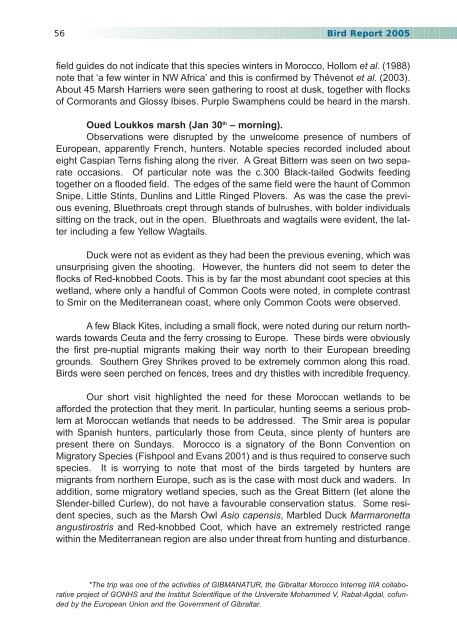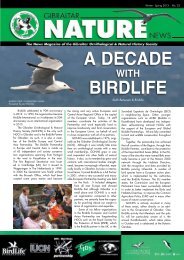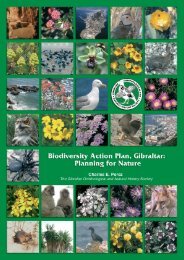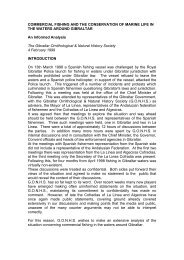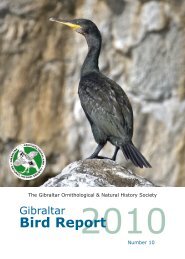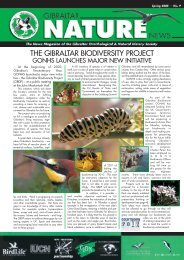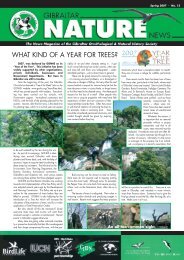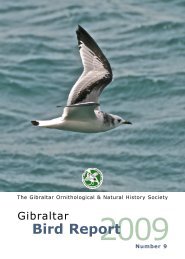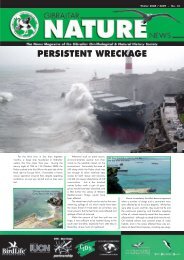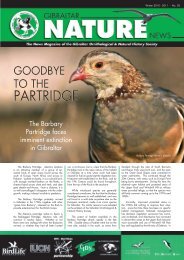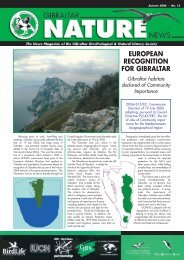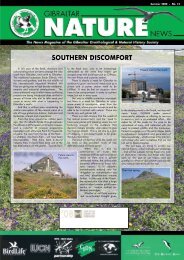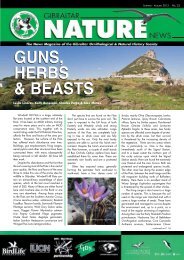2005 (No 5) - Gibraltar Ornithological & Natural History Society
2005 (No 5) - Gibraltar Ornithological & Natural History Society
2005 (No 5) - Gibraltar Ornithological & Natural History Society
You also want an ePaper? Increase the reach of your titles
YUMPU automatically turns print PDFs into web optimized ePapers that Google loves.
56 Bird Report <strong>2005</strong><br />
field guides do not indicate that this species winters in Morocco, Hollom et al. (1988)<br />
note that ‘a few winter in NW Africa’ and this is confirmed by Thévenot et al. (2003).<br />
About 45 Marsh Harriers were seen gathering to roost at dusk, together with flocks<br />
of Cormorants and Glossy Ibises. Purple Swamphens could be heard in the marsh.<br />
Oued Loukkos marsh (Jan 30 th – morning).<br />
Observations were disrupted by the unwelcome presence of numbers of<br />
European, apparently French, hunters. <strong>No</strong>table species recorded included about<br />
eight Caspian Terns fishing along the river. A Great Bittern was seen on two separate<br />
occasions. Of particular note was the c.300 Black-tailed Godwits feeding<br />
together on a flooded field. The edges of the same field were the haunt of Common<br />
Snipe, Little Stints, Dunlins and Little Ringed Plovers. As was the case the previous<br />
evening, Bluethroats crept through stands of bulrushes, with bolder individuals<br />
sitting on the track, out in the open. Bluethroats and wagtails were evident, the latter<br />
including a few Yellow Wagtails.<br />
Duck were not as evident as they had been the previous evening, which was<br />
unsurprising given the shooting. However, the hunters did not seem to deter the<br />
flocks of Red-knobbed Coots. This is by far the most abundant coot species at this<br />
wetland, where only a handful of Common Coots were noted, in complete contrast<br />
to Smir on the Mediterranean coast, where only Common Coots were observed.<br />
A few Black Kites, including a small flock, were noted during our return northwards<br />
towards Ceuta and the ferry crossing to Europe. These birds were obviously<br />
the first pre-nuptial migrants making their way north to their European breeding<br />
grounds. Southern Grey Shrikes proved to be extremely common along this road.<br />
Birds were seen perched on fences, trees and dry thistles with incredible frequency.<br />
Our short visit highlighted the need for these Moroccan wetlands to be<br />
afforded the protection that they merit. In particular, hunting seems a serious problem<br />
at Moroccan wetlands that needs to be addressed. The Smir area is popular<br />
with Spanish hunters, particularly those from Ceuta, since plenty of hunters are<br />
present there on Sundays. Morocco is a signatory of the Bonn Convention on<br />
Migratory Species (Fishpool and Evans 2001) and is thus required to conserve such<br />
species. It is worrying to note that most of the birds targeted by hunters are<br />
migrants from northern Europe, such as is the case with most duck and waders. In<br />
addition, some migratory wetland species, such as the Great Bittern (let alone the<br />
Slender-billed Curlew), do not have a favourable conservation status. Some resident<br />
species, such as the Marsh Owl Asio capensis, Marbled Duck Marmaronetta<br />
angustirostris and Red-knobbed Coot, which have an extremely restricted range<br />
within the Mediterranean region are also under threat from hunting and disturbance.<br />
*The trip was one of the activities of GIBMANATUR, the <strong>Gibraltar</strong> Morocco Interreg IIIA collaborative<br />
project of GONHS and the Institut Scientifique of the Universite Mohammed V, Rabat-Agdal, cofunded<br />
by the European Union and the Government of <strong>Gibraltar</strong>.


